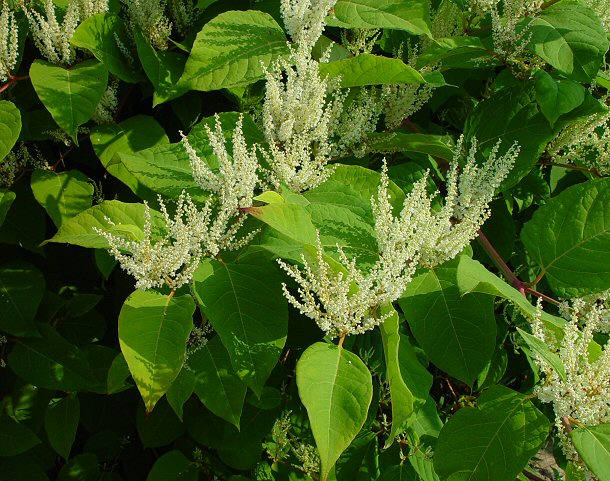Fallopia japonica (Houtt.) Ronse Decr.
Japanese Knotweed

Introduced
CC = *
CW = 3
MOC = 17
© DETenaglia
Fallopia japonica (Houtt.) Ronse Decr.Japanese Knotweed | |
 |
Introduced CC = * CW = 3 MOC = 17 |
© DETenaglia |
|
Family - Polygonaceae Habit - Perennial forb, with somewhat woody rootstocks and widely creeping rhizomes, forming dense colonies, usually functionally dioecious (staminate plants occasionally with a few pistillate or perfect flowers). Stem - Stout, arching or ascending to erect, to 2.5 m, glabrous, sometimes glaucous. Ocreae 4-10 mm long, oblique at the tip, the surface glabrous or minutely hairy, tan.
Leaves - Simple, petiolate. Blades 4-15 cm long, 2-10 cm wide, ovate, broadly angled or rounded to shallowly cordate at the base, tapered to a sharply pointed tip, the upper surface glabrous, the undersurface roughened or sparsely pubescent along the veins with minute, unicellular, stout, knob-shaped to bluntly pointed hairs, also gland-dotted, sometimes also somewhat glaucous.
Inflorescences - Terminal and axillary, panicles or rarely reduced to racemes, the flowers 3-10 per fascicle, mostly staminate or pistillate (rarely perfect), the flower stalks 3-5 mm long, winged to below the midpoint, jointed at or below the midpoint.
Flowers - On stalks 3-5 mm long, jointed at or below the perianth base, winged to below the midpoint. Tepals 5 in 2 whorls, 2-4 mm long, becoming enlarged to 4-10 mm at maturity, those of the inner whorl mostly elliptic, those of the outer whorl obovate, tapered and decurrent along the stalklike base, glabrous, white, greenish white, or pink to reddish pink, the outer 3 tepals with dorsal wings 1.4-2.0 mm wide at fruiting. Stamens (in staminate or perfect flowers) 8, the filaments sometimes hairy toward their bases. Styles 3, sometimes fused toward the base or nearly to the tip, the stigmas divided into numerous, slender fringelike lobes.
Fruits - Achenes 2.3-3.5 mm long, enclosed in the persistent perianth, 3-angled, unwinged, elliptic to ovate in outline, short-beaked, dark brown, glabrous, smooth, shiny. Flowering - July - October. Habitat - Forest edges, streambanks, saline seeps, ditches, old homesites, open disturbed areas. Origin - Native to Asia. Lookalikes - None. Other info. - This introduced plant has been widely cultivated. It is found in scattered locations throughout Missouri, as well as much of the continental U.S., with the greatest preponderance in the northeastern and northwestern parts of the country. The coarse foliage and sprays of small white flowers are distinctive. Photographs taken in Marquette, MI., 9-8-03 (DETenaglia), also in Bonne Terre, St. Francois County, MO, 8-29-2019 (SRTurner). |